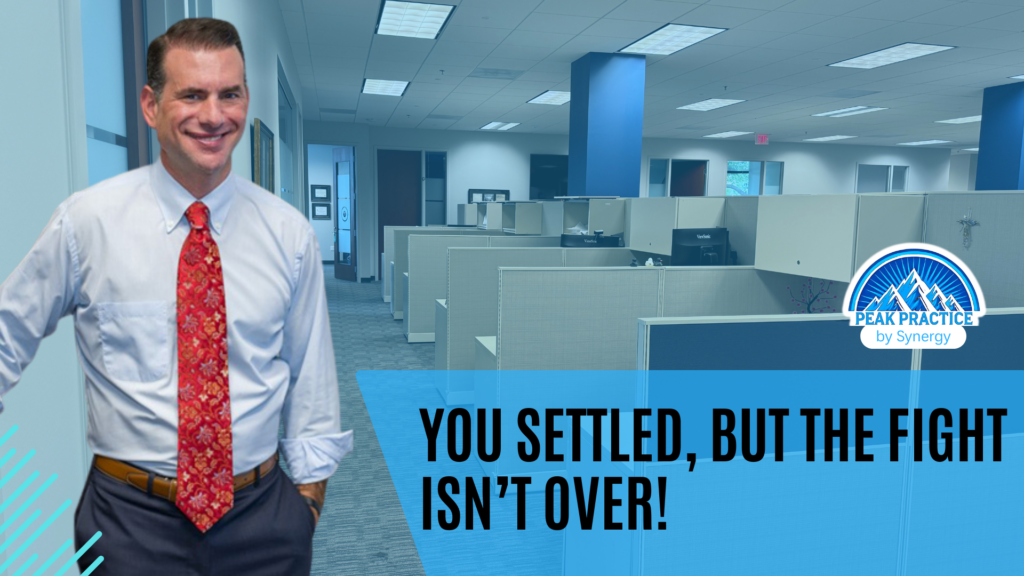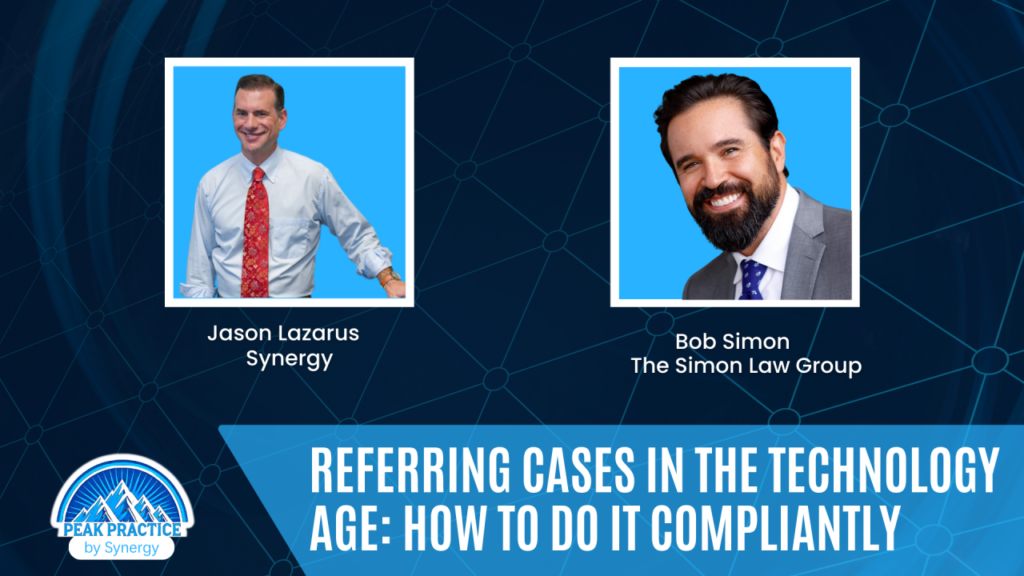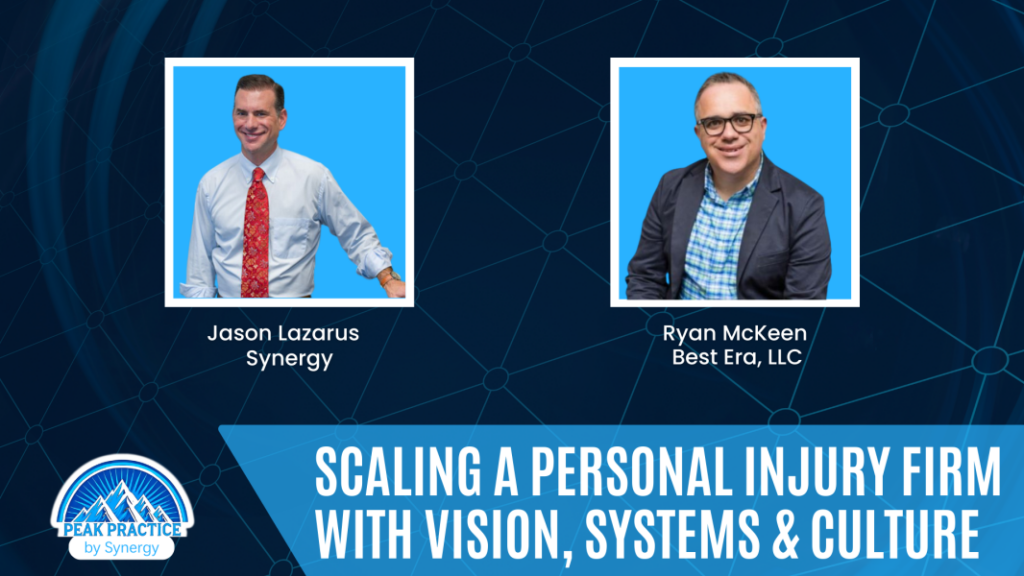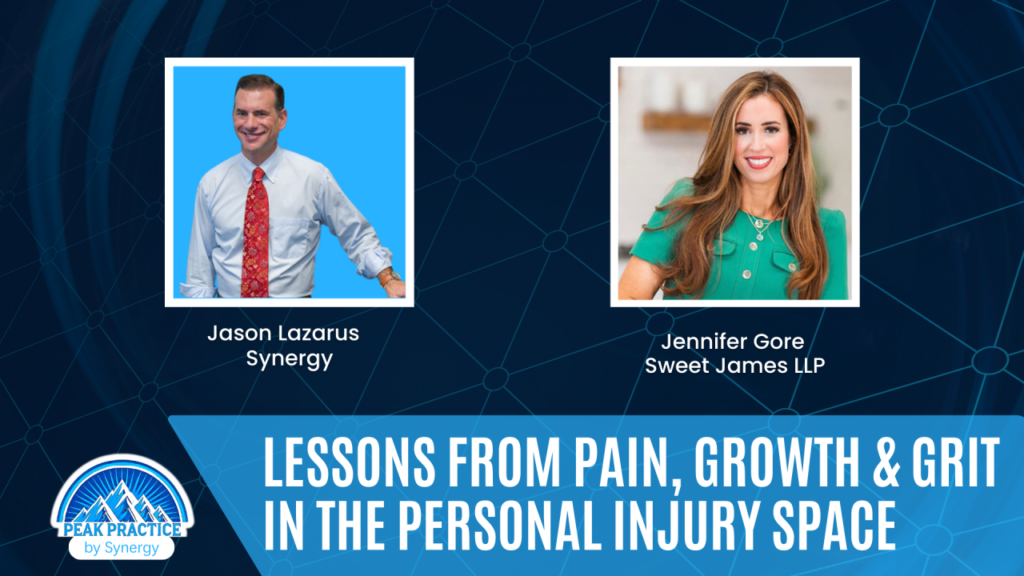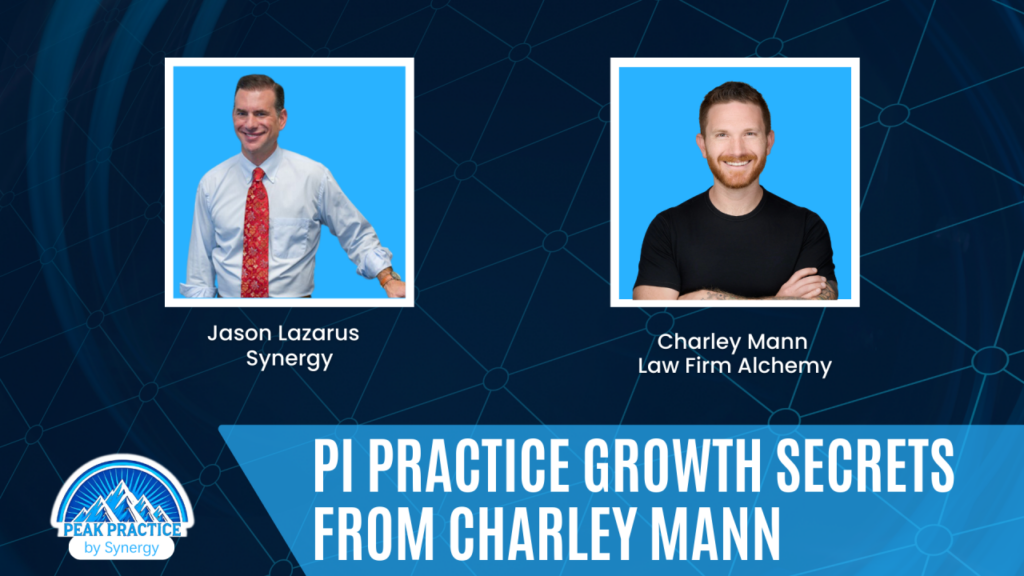PEAK PRACTICE
Peak Practice is a community that delivers expert industry insights on how to scale, streamline, and accelerate personal injury law practices. By providing knowledge and resources on law firm operations, marketing, and business growth, Peak helps personal injury attorneys gain a competitive edge. As the leader in lien resolution, Synergy partners with firms to eliminate settlement bottlenecks, optimize client outcomes, and drive greater profitability—so you can focus on securing justice. Join the community here and discover how partnering with Synergy helps you achieve Peak Practice.
Below are our Synergy InSights on all things related to Peak Practice.
You finally resolved your client’s case. The battle is over. Your client is thrilled with the result. Then you get hit with: “We’re asserting a lien on the proceeds.”
And just like that, closing the case turns into a lien resolution-fueled nightmare.
📉 The Hidden Profit Killer in Personal Injury Law
Lien resolution is the dreaded post-settlement purgatory for personal injury law firms.
It’s tedious. It’s high stakes for your client as it impacts net. And worst of all? It’s work that quietly eats away at your margins and your team’s time.
You didn’t go to law school to chase down lien holder recovery vendor reps or argue ERISA subrogation rights at 9 p.m.
But here you are.
❓ Do I really need this headache?
Here’s a quick taste of the headaches firms face when handling liens in-house:
- Is it a lien, a debt, or just a reimbursement obligation? (Answer: it depends. . .)
- Does the plan get application of federal or state law?
- Is the lien even valid?
- What’s the reduction strategy? (Standard statute reductions, waiver opportunities, equitable defenses?)
- **Has the client been made whole? Can you even argue that anymore under the plan’s language?
Each of these questions is a trapdoor. Miss one and you create unwanted liability.
🚨 Why It’s So Dangerous to Go it Alone?
If you’re handling liens solo or relying on team members without deep experience in this area, you’re walking through a subro minefield blindfolded.
Some potential consequences:
- Personal liability for unpaid liens
- Delays in disbursing funds (angry clients + stalled cash flow)
- Missed reductions that cost your client thousands—and your firm, future referrals
Even worse? It can make you look bad right before the client walks out your door.
💡 The Smarter Way: Systematize or Outsource
Trial lawyers should be in the courtroom—or working on future cases—not decoding plan language or chasing down lien holders to resolve liens.
So, what are your options?
- Build a process. For liens you will handle in-house (like local providers or very small liens), create a standardized protocol for identifying, verifying, negotiating, and resolving liens. Treat it like litigation prep: methodical and documented.
- Outsource strategically. Partnering with experts (like Synergy) not only protects you and your client—it accelerates resolution, ensures compliance, and gets everyone paid faster (most of the time).
Closing Thought 🧠
You can’t grow your practice if you’re stuck in the weeds of lien resolution. Efficiency isn’t optional—it’s a competitive advantage.
Want to Stop Losing Hours to Lien Nightmares?
Join the Peak Practice Community, and learn how synergy. can help you eliminate settlement bottlenecks, resolve complex liens, and maximize recoveries. Learn more here: https://partnerwithsynergy.com/peak-practice/
If you want to grow and scale your law firm more effectively, consider partnering with synergy. for lien resolution. Learn more at: https://partnerwithsynergy.com/liens/
💼 See how synergy. can help your firm reclaim time and drive greater profitability
In the personal injury world, attorney referrals are common — but they also come with risk if Medicare is involved (or other lienholders). When Medicare is involved, as the referring attorney you need to make sure you have three things:
1) A written fee sharing agreement;
2) A copy of the lawyer’s malpractice insurance policy declarations and
3) Proof that the lawyer has engaged lien resolution experts to resolve Medicare Conditional Payment obligations or written assurance that the firm will resolve it compliantly.
When you refer out a case, you don’t refer away your responsibilities. It is possible that referring attorneys are held liable for unresolved liens — even after a case is completely handed off. Medicare is especially unforgiving. U.S. Attorney Robert K. Hurt put it bluntly: “Plaintiffs’ attorneys cannot refer a case… and simply wash their hands clean of their obligations to reimburse Medicare.”
Miss a Medicare lien? It could be on you as the referring attorney.
What are Best Practices to Protect Your Firm on Referred Cases with Liens?
To stay compliant and avoid liability — especially with Medicare liens — follow these five basic rules:
· Communicate Clearly: Referring attorneys should share all known or potential liens up front, including any Medicare involvement.
· Do Your Homework: Receiving attorneys must investigate and address all liens, complying with the Medicare Secondary Payer Act.
· Written Authorization: Secure client authorization before taking any lien-related actions.
· Work Together and Engage a Lien Resolution Partner: Coordinate on a timely, cost-effective lien resolution strategy.
· Keep Records: Document everything — communication, authorizations, and lien actions.
Is There a Technology Solution for Referrals that Protects Everyone?
YES! I recently spoke with Robert Simon on the Trial Lawyer View by Synergy podcast about such a technology!! Have you heard of Attorney Share? Attorney Share is the first AI-powered referral platform built for attorneys, by attorneys — and it’s transforming how firms manage case referrals. How does it change the game? It tracks referrals automatically! No more chasing status updates. You get real-time updates on every case you refer. Additionally, it protects you, your firm and the client. The Attorney Share integration tools help ensure lien issues, especially Medicare’s, don’t fall through the cracks. As a bonus, it helps monetize every opportunity, inbound or outbound — every referral becomes a potential revenue stream. Thousands of new cases are added monthly to Attorney Share. Lastly, and importantly, it is free to join, and Attorney share never takes a percentage of your referral fee.
Referrals Made Smarter. And Safer.
With Attorney Share, you’re not just sending cases into the void. You’re keeping visibility, control, and compliance — while also protecting yourself from the very real risk of lien-related liability.
Want to learn more about how to leverage Attorney Share? Visit https://www.attorneyshare.com/ for more information.
If you are looking for a lien resolution partner with an expert team to protect your firm from potential Medicare liability, learn more about synergy. by visiting https://partnerwithsynergy.com/liens/liens-we-handle/medicare/
Join the Peak Practice Movement
If you’re a personal injury lawyer ready to scale, streamline, or step into your role as CEO, let’s talk. Subscribe to the newsletter, join the Peak Practice community, and learn how Synergy can help you eliminate settlement bottlenecks, resolve complex liens, and maximize recoveries. Learn more here: https://partnerwithsynergy.com/peak-practice/
#MedicareConditionalPayment #RobertSimon #AttorneyShare #PeakPractice #PartnerWithSynergy
by Jason D. Lazarus | Peak Practice by Synergy
What if I told you the road to a $100M verdict starts with a barstool conversation, a Google Doc, and a decision?
That’s exactly how Ryan McKeen of Best Era, LLC, began his journey in building a personal injury practice—going from a two-person shop to a 40+ person powerhouse in just five years. The firm didn’t just scale—it exploded, tripling revenue and securing one of the largest jury verdicts in state history.
How did they do it?
I sat down with Ryan on the Trial Lawyer View by Synergy podcast to unpack the core strategies behind his firm’s meteoric rise and to learn more about Best Era, LLC. The insights are gold for any personal injury lawyer thinking about building not just a law firm, but a scalable, resilient business.
Here are the takeaways that every trial lawyer needs to hear:
Growth Is a Choice—Vision Is the Catalyst
“The size of your firm is largely a choice.” That’s how Ryan kicks off the conversation—and it sets the tone. Before any systems were built or staff hired, Ryan and his partner made a conscious decision to grow. They mapped out a 10-year vision using the EOS Worldwide Vision/Traction Organizer (VTO), committing to a goal that seemed outlandish at the time: a $10M jury verdict.
That choice changed everything.
Their vision drove every operational decision—from adopting Filevine early on to hiring with purpose and investing in high-stakes litigation infrastructure. Within five years, that vision became reality in the form of a $100M verdict for a deserving client.
Lesson: Start with the end in mind. Then reverse-engineer your firm’s structure to support that future.
Systems Win (Yes, Really)
You can’t build a high-performing trial team if you’re stuck figuring out how to buy stamps.
McKeen shared a hilarious yet painfully relatable story about a summer employee who spent five hours trying to figure out postage. That’s when he knew: they needed systems.
So they built an 800+ page internal wiki, documenting everything from how to mail a letter to how to prep for trial. It became their firm’s operating system.
Why it matters: Great lawyering is wasted without great execution. And great execution comes from process.
“We built systems not just to do the work—but to make it easier to do the work the next 500 times.” —Ryan McKeen
Culture = What You Do (Not What You Say)
Ryan’s definition of culture isn’t abstract. It’s behavioral.
At his firm, culture looked like this: “If it’s not in the wiki, it doesn’t exist.” “Did you check the wiki first?” “If it’s missing, go make the page.”
This created a shared responsibility for improvement. Every employee became a builder of the firm’s future.
Result: They didn’t just scale—they scaled without chaos.
The First Hire That Changes Everything
When should you hire your first admin?
Ryan is crystal clear: the fifth hire should be administrative. At that point, the firm dynamics change. Communication breaks down. Systems strain. You need someone making sure the lights stay on and the printer works, so your legal team can focus on high-value tasks.
“Firms that hire admin help at 5 can scale to 15. Firms that don’t? They get stuck.”
That single hire often determines whether you’ll break through the next growth ceiling—or spin your wheels.
Your Job as CEO: Stop Practicing Law or Hire a CEO
It sounds counterintuitive, but Ryan insists that truly scaling requires stepping out of legal work and into leadership.
By the time he fully stepped into the CEO role, Ryan was out of cases and 100% focused on vision, operations, and team performance. They implemented EOS fully, brought in a COO, and used leadership meetings to keep the firm aligned and accountable.
If you want to scale beyond 25-30 people, you need to think like a CEO—not a senior partner.
Communities Are Your Competitive Advantage
Ryan credits much of his firm’s success to legal masterminds, where he learned everything from financial structuring to workflow design.
“Ignorance is very expensive. But wisdom? You can borrow it for free.”
His advice? Surround yourself with people who’ve already done what you’re trying to do. Borrow their playbooks. Learn from their scars.
Now He’s Teaching the Way Forward
Today, Ryan is building Best Era, LLC, a consultancy for law firms ready to scale. He teaches at UConn Law and is launching “The Way”—an online course and book for PI lawyers under $1M in revenue who want a roadmap to growth.
His mission? Help 12,500 lawyers in five years accelerate their law firm journey—with fewer missteps, more clarity, and better systems.
Final Thought: Authority Comes from Doing and Sharing
Ryan didn’t grow a firm by chasing trends—he grew it by executing on vision, building operational mastery, and committing to a culture of improvement.
And now? He’s teaching others how to do the same.
If you’re a personal injury trial lawyer looking to scale your impact, systematize your operations, and claim your place among the best—this is a blueprint.
Subscribe to the Peak Practice Newsletter for more expert insights, exclusive podcast recaps, and law firm growth strategies you won’t find anywhere else.
If you’re a personal injury lawyer ready to scale, streamline, or step into your role as CEO, let’s talk. Join the Peak Practice Community, and learn how synergy. can help you eliminate settlement bottlenecks, resolve complex liens, and maximize recoveries. Learn more here: https://partnerwithsynergy.com/peak-practice/
If you want to listen or watch the Trial Lawyer View by Synergy podcast episode with Ryan McKeen for even more insights, you can do so here: https://triallawyerview.com/podcast/ryan-mckeen/
If you want to grow and scale your law firm more effectively, consider partnering with synergy. for lien resolution. Learn more at: https://partnerwithsynergy.com/liens/
By Jason D. Lazarus | Peak Practice by Synergy
✨Jennifer Gore✨ of Sweet James LLP , founder of one of the fastest-growing women-led personal injury firms in the U.S., joined me on the Trial Lawyer View by Synergy podcast to explore how trauma, grit, and business acumen converge to shape law firm growth. What started as a conversation about our life-changing accidents became a masterclass in building a resilient, scalable practice.
If you want to lead with authenticity, scale sustainably, and build a brand that can weather the chaos of life and litigation—this one’s for you.
From Collision to Calling
Both Jennifer and I have experienced devastating accidents due to the negligence of others. These moments don’t just injure the body—they redefine your mission. For Jennifer, a serious car crash in college became the seed of her career. For me, a cycling accident left me in the ICU in a medically induced coma, reshaping my understanding of what injured clients endure.
These lived experiences taught us something powerful: empathy is the key.
We can’t teach our teams to be trauma survivors. But we can share our stories to help them serve with purpose.
You Don’t Need to Be the CEO—But Someone Must Be
Jennifer credits much of her success to treating her firm like a business from day one. She broke from the “practice vs. business” mindset, understanding that even the best legal talent will struggle without systems, leadership, and financial discipline.
The number one reason lawyers get disbarred isn’t bad lawyering, she said. “It’s mismanagement of their law firm.”
This is the Peak Practice mindset: marrying great legal work with operational excellence.
Coaching, Masterminds, and the Myth of the Lone Wolf
Jennifer’s growth didn’t happen in a vacuum. She immersed herself in coaching programs, surrounded herself with top trial lawyer mentors, and invested in her personal development.
She didn’t just scale her firm. She scaled herself.
Her coaching practice, Evergreen, grew organically from that journey. Now, she’s mentoring other law firm owners to avoid the same pitfalls.
The Danger of Departments of One
One of Jennifer’s most powerful insights: “The worst number in business is one.”
If one person in your firm owns a function and they leave, everything breaks. Her solution? Redundancy, cross-training, and scalable systems. This operational depth isn’t just about peace of mind. It’s about empowering your team and giving them the freedom to take ownership.
Want to go on vacation and not have your inbox explode? Build a team that can cover each other.
Branding Is Just Being Boldly You
Jennifer’s take on marketing is refreshingly simple: be yourself, and be excellent at it. Her LinkedIn presence is a mix of vulnerability, expertise, and value. Not everyone will love your style. That’s okay. You’re not trying to be everything to everyone.
“Nobody can compete with me on being me.”
That’s the essence of powerful personal branding.
Final Thought: You Were Built for This
Whether you’re a lawyer who came to this work through personal pain, or someone scaling a firm from scratch with no blueprint—you have what it takes.
You don’t have to do it alone. Surround yourself with people who’ve walked the path, lean into your uniqueness, and don’t be afraid to run your firm like the business it is.
This is what Peak Practice is all about: operational clarity, strategic partnerships, and a relentless commitment to better outcomes for you and your clients.
Join the Peak Practice Movement
If you’re a personal injury lawyer ready to scale, streamline, or step into your role as CEO, let’s talk. Subscribe to the newsletter, join the Peak Practice Community, and learn how synergy. can help you eliminate settlement bottlenecks, resolve complex liens, and maximize recoveries. Learn more here: https://partnerwithsynergy.com/peak-practice/
If you want to listen or watch the Trial Lawyer View by Synergy podcast episode with Jennifer Gore for even more insights, you can do so here: https://triallawyerview.com/podcast/jennifer-gore/
If you want to grow and scale your law firm more effectively, consider partnering with synergy. for lien resolution. Learn more at: https://partnerwithsynergy.com/liens/
#PersonalInjuryLaw #TrialLawyers #LegalMarketing #LawFirmGrowth #Entrepreneurship #PeakPractice #TrialLawyerView
9 Types of Liens to Get Help With
For personal injury law firms, healthcare lien resolution isn’t just a backend process—it’s a critical part of case resolution and a key to client satisfaction. But not all liens are created equal. Knowing which ones to partner with experts on and which to manage internally can save your team time, reduce liability, and increase your firm’s profitability.
Liens Where Employing Experts Pays Off!
Partnering with an expert team of subrogation experts, like synergy., can pay huge dividends for your client as well as for your law firm’s productivity when dealing with:
· Medicare Conditional Payments: These involve regulatory minefields, strict deadlines, and complex compromise/waiver processes. Missing a step can be very costly.
· Medicare Advantage (Part C) Liens: Even more nuanced than traditional Medicare, these liens carry personal liability risks and potential double damages.
· Medicaid Third Party Liability: State-specific rules and the need for Ahlborn reductions make these ideal for specialists who understand the negotiation landscape and legal nuances.
· ERISA (Employer-Sponsored Plan) Liens: Governed by federal law and full of dense plan language, ERISA liens demand precision. If you’re not reading plan documents daily and up to date on the best angle of attack, outsource this.
· FEHBA: These liens involve federal regulations that can be intricate and challenging to interpret. FEHBA is very similar to ERISA, outsource it if you don’t know the nuances.
· Military Health Plan Liens: Military health plan liens are governed by specific federal laws and each branch of the military has different processes that can be difficult to navigate. Like FEHBA, outside expertise can be invaluable.
· Hospital and Provider Liens: Often highly inflated, these liens require aggressive negotiation based on real cost of care—not full billed charges.
· Private Health Insurance Liens: These are governed by policy terms and state law. Subrogation-savvy firms can unlock substantial reductions that might be missed.
· Multi-Jurisdictional Liens: When cases cross state lines, choose a team that knows the rules everywhere, not just in your ZIP code.

When May A Lien Best Handled In-House?
While many law firms can benefit from experts in lien resolution, some types of liens may just not be appropriate for outsourcing:
· Small Liens (≤ $2,000): For these liens, your team might resolve them faster—though synergy. does handle any size lien if you prefer full outsourcing.
· Local Provider Liens: If you have strong relationships with nearby providers, leverage them for goodwill and favorable outcomes.
· Workers’ Comp Liens: Highly state-specific and typically best handled by someone well-versed in local WC laws.
· Medicaid Estate Recovery: State agencies manage these claims, which hinge on state law with state specific resolution processes.
· Child Support Liens: Strictly governed by state statute and typically formulaic. Best left to your local legal team.
· Pre-Settlement Funding Liens: These are contract-based. Unless there’s a dispute, most follow straightforward repayment terms.
The Bottom Line
Not every lien needs to be outsourced—but the ones that are appropriate can really benefit from an expert like synergy. .
Knowing where to draw the line between handling it yourself and expert resolution is key to maximizing net recovery and reducing case bottlenecks. Evaluate complexity, risk, and your firm’s internal workload to decide what is right. Making the right choice on lien resolution isn’t just about efficiency—it’s about protecting your client’s recovery and your firm’s bottom line.
If you want to recapture more of your team’s time, free your burdened staff and supercharge lien resolution results, consider partnering with synergy. for lien resolution. Visit https://partnerwithsynergy.com/liens/why-partner/ to learn more.
#PersonalInjury #LienResolution #MedicareLiens #ERISALiens #PIattorneys #LegalOps #LawFirmStrategy #SynergyLienResolution #TrialLawyers #HealthcareLiens
https://www.linkedin.com/pulse/outsource-lien-resolution-guide-every-personal-injury-jason-d–sleue
In the latest episode of Trial Lawyer View by Synergy podcast, I sat down with Charley Mann, founder of Law Firm Alchemy, to dive deep into law firm growth—and came away with a masterclass in metaphors, mindset, and metrics.
Charley doesn’t just coach lawyers—he redefines what it means to lead a law firm. Whether you’re stuck in growth purgatory or just trying to keep your head above water, Charley’s insights will resonate.
Here are some of the top takeaways from our conversation:
The BUSINESS of Running a Law Firm
Why Law Firm Growth Is About Endurance
Charley shared that training for a marathon—even while battling “cuboid syndrome”—has shaped how he thinks about business. The key lesson?
“You have to pace yourself. So many law firm owners go hard at first, then burn out—just like runners who go out too fast and get passed by the steady pack.”
The metaphor? Law firm growth requires consistent, measured effort—not flashy, unsustainable bursts.
Mindset Shift
One of Charley’s five core challenges law firm owners face: Shedding the belief that doing great work alone brings in clients.
“You have to accept that marketing is primary. And referrals? Those are outbound too.”
Charley’s checklist for escaping growth plateaus:
- Get serious about outbound and digital marketing
- Track key metrics (new cases, closed matters, production)
- Start buying back your time and delegate
- Replace yourself strategically
- Redefine your identity from lawyer to entrepreneur
Entrepreneurship as Daily Practice
For lawyers who don’t have a business background, Charley suggests building your entrepreneurial chops like a muscle:
- Send a marketing email.
- Post a video.
- Read a business book.
“Do one entrepreneurial thing every day.” (And if you’re a soccer parent like Charley, he calls these your “hundreds”—small daily reps that lead to big growth.)
What Chess Can Teach Law Firm Owners
Surprisingly, chess offers a powerful metaphor: success isn’t about flashy tactics. It’s about mastering the fundamentals, just like knowing your marketing metrics and managing your team.
“Most people want clever tactics, but they never studied the openings. That’s why they keep getting crushed.”
Importance of Metrics in Running a Law Firm
Metrics Matter More Than You Think
If you’re not measuring, you’re guessing. And if you’re guessing, you’re likely losing.
Charley advises firms to forecast revenue on a quarterly basis, even if they’re wrong at first. “You can’t get better at predicting until you start trying to predict.”
And that “money bolus” in your head? Don’t let it stop you from resolving cases quickly. Velocity + clarity beats bloat every time.
Predictive Metrics: Operate with Eyes on the Road Ahead
Charley emphasized using predictive data—not just historical reports. Revenue projections, file velocity, and operational dashboards aren’t just for tech startups. They’re essential to scaling law firms.
“You can’t be right unless you start measuring.”
Leading & Managing People
Leadership Insight
Charley dropped a line that stuck:
“If you’re not growing, your team can’t grow. You are the lid on what’s possible.”
Leadership isn’t about being everyone’s friend—it’s about setting a direction and curating a crew who want to go there with you. That means moving away from the “we’re a family” mindset and toward being the captain of the ship. Letting go of poor performers isn’t cruelty—it’s integrity to your mission and your high-performing crew. The best people will thank you for it.
Culture, Integrity, and Showing Up
Integrity isn’t built on grand gestures—it’s built on patterns.
“Tell your client you’ll call at 3 PM? Move heaven and earth to do it.”
Patterns of showing up and communicating consistently create trust—internally with your team and externally with clients.
Getting Ahead with Marketing
3 Marketing Strategies You Should Be Using Right Now
- Referral Marketing: Build and nurture a list. Weekly emails. Two calls per week. Mail something real.
- Local Service Ads: Love them or hate them—test them every 6 months. They can be a game-changer.
- Broadcast + OTT Advertising (For larger firms): Scale omnipresence with TV, radio, and streaming ads.
Referral Marketing 2.0: Build a List, Nurture It Like Gold
His 3-part framework:
- 2 live interactions/week (coffee, calls, Zoom)
- 1 weekly email (not monthly—weekly!)
- Print newsletter or personal touches by mail
Your referral network isn’t built on chance—it’s built on rhythm and relationships.
Conclusion
Charley’s Final Thought
“Know yourself. Own your identity. And don’t be afraid to grow into the person your business needs you to be.”
Whether you’re a lawyer trying to grow a small practice, or a $15M+ firm trying to break through the next ceiling, Charley’s message is clear: growth starts with you—and your willingness to do the boring, beautiful work of becoming a better leader.
Learn more about Charley and Law Firm Alchemy: www.lawfirmalchemy.com
Listen to the full episode of the Trial Lawyer View by Synergy podcast for even more growth insights: https://triallawyerview.com/podcast/charley-mann/
If you want to grow and scale your law firm more effectively, consider partnering with synergy. to eliminate bottlenecks at settlement due to liens. Learn more at: https://partnerwithsynergy.com/liens/
https://www.linkedin.com/pulse/pi-practice-growth-secrets-from-charley-mann-how-run-jason-d–axyte
BLOGS
READY TO SCHEDULE A CONSULTATION?
The Synergy team will work diligently to ensure your case gets the attention it deserves. Contact one of our legal experts and get a professional review of your case today.

